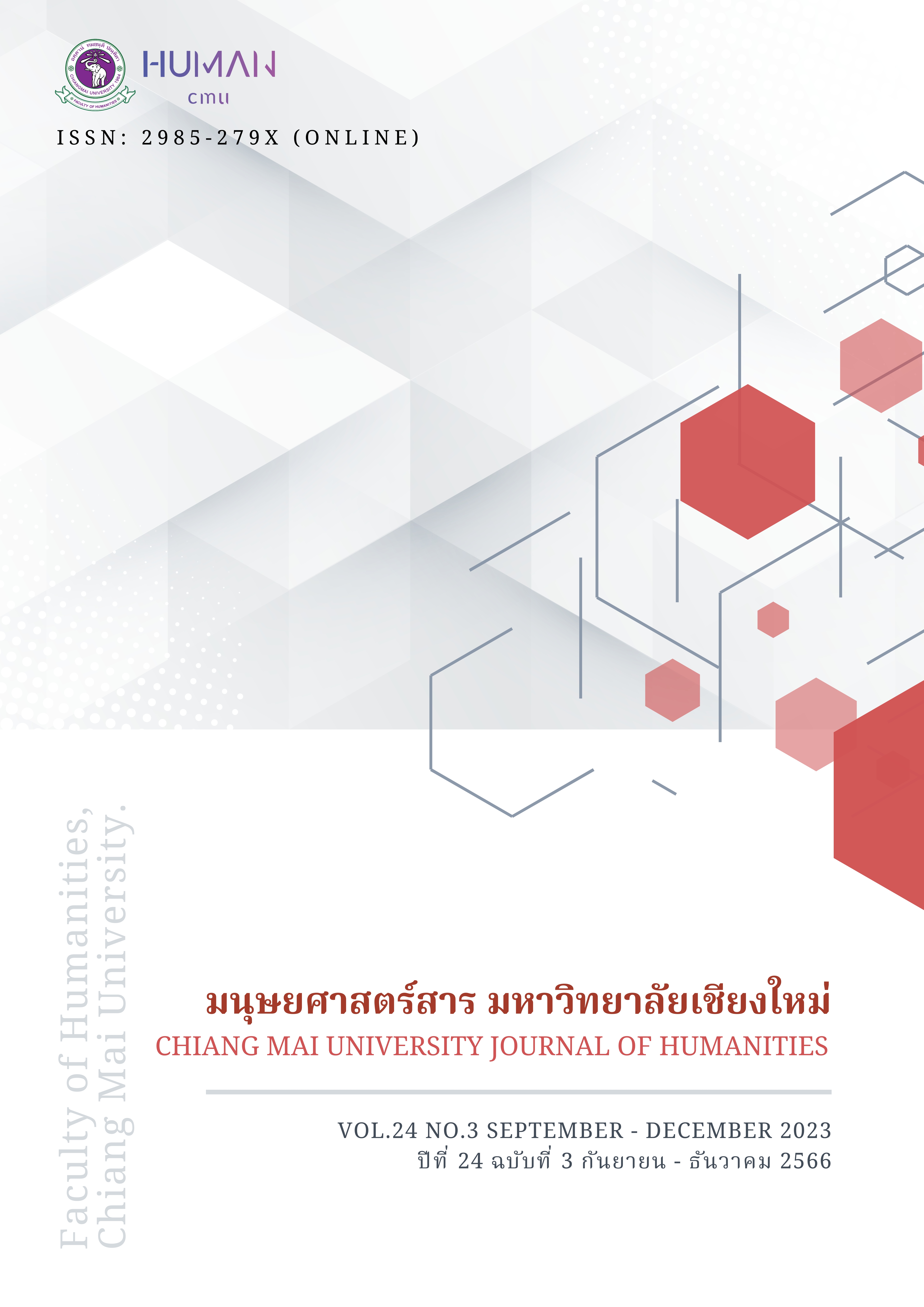วีล็อกท่องเที่ยวภาษาเยอรมันในฐานะตัวบทที่ใช้สื่อหลากรูปแบบ: การศึกษากลวิธีเพื่อทำให้ผู้รับชมรู้สึกมีส่วนร่วมกับสถานการณ์
Main Article Content
บทคัดย่อ
วีล็อกท่องเที่ยวพัฒนามาจากบันทึกการเดินทางและบล็อกท่องเที่ยวซึ่งเป็นตัวบทที่ใช้ภาษาเขียนเป็นหลักในการถ่ายทอด แต่ด้วยพัฒนาการด้านเทคโนโลยีการสื่อสารทำให้วีล็อกท่องเที่ยวสามารถใช้ทั้งภาษาพูด
อวัจนภาษาท่าทางและองค์ประกอบภาพวิดีทัศน์ร่วมกันในการสื่อสารได้ วีล็อกท่องเที่ยวจึงกลายเป็นตัวบทที่ใช้สื่อหลากรูปแบบและมีกลวิธีการใช้วัจนภาษาร่วมกับอวัจนภาษาท่าทางและองค์ประกอบภาพในวิดีทัศน์ที่มีลักษณะเฉพาะ งานวิจัยชิ้นนี้มีวัตถุประสงค์เพื่อศึกษากลวิธีการใช้อวัจนภาษาท่าทางที่ปรากฏร่วมกับวัจนภาษาและองค์ประกอบภาพในวิดีทัศน์ที่ทำให้ผู้รับชมรู้สึกมีส่วนร่วมกับสถานการณ์ โดยวิเคราะห์วีล็อกท่องเที่ยวภาษาเยอรมันที่เผยแพร่บนแพลตฟอร์มยูทูป (YouTube) ในปีพ.ศ. 2562 จำนวนทั้งสิ้น 12 วีล็อก จากช่องยูทูปที่ไม่ซ้ำกัน วีล็อกที่นำมาวิเคราะห์มีความยาวประมาณ 10-25 นาที มีผู้พูดหลักเพียงคนเดียวทำหน้าที่นำเสนอสถานที่ท่องเที่ยวในประเทศที่ตั้งอยู่นอกทวีปยุโรป
จากการวิจัยพบว่า การเคลื่อนกล้องเป็นกลวิธีทางอวัจนภาษาท่าทางที่ใช้บ่อยที่สุดในวีล็อกท่องเที่ยว โดยฉายภาพแสดงสถานที่ เหตุการณ์หรือสิ่งของเพื่อแสดงสถานที่โดยรอบหรือดึงความสนใจของผู้รับชมไปยังสิ่งที่ผู้ส่งสารต้องการกล่าวถึง การเคลื่อนกล้องเพื่อฉายภาพดังกล่าวมักปรากฏร่วมกับวัจนภาษาคือ การบอกเวลาผ่านกาลของคำกริยา ดรรชนีพจน์แสดงถึงผู้พูดหรือผู้ฟัง ดรรชนีพจน์บอกสถานที่ ดรรชนีพจน์บอกเวลาและคำหรือวลีที่บ่งชี้สิ่งของหรือเหตุการณ์ โดยมักสัมพันธ์กับการใช้ภาพช่วยยืนยันคำพูด (mit Bildern authentisieren) และการใช้ภาพเชื่อมโยงคำพูดเข้ากับผู้พูด (mt Bildern autorisieren) นอกจากนี้การใช้คำหรือวลีที่บ่งชี้สิ่งของหรือเหตุการณ์ร่วมกับการเคลื่อนกล้องเพื่อฉายภาพสถานที่ เหตุการณ์หรือสิ่งของนั้น องค์ประกอบต่าง ๆ มีความสัมพันธ์แบบภาพบอกความหมายแทนคำพูด (mit Bildern semantisieren) ส่วนการใช้ดรรชนีพจน์บอกสถานที่สามารถวิเคราะห์ได้ว่าแสดงความสัมพันธ์แบบใช้ถ้อยคำเพื่อแสดงให้องค์ประกอบเฉพาะของภาพเด่นชัด (mit Worten sehen) โดยคำพูดจะชี้ให้ผู้รับชมมองเห็นเฉพาะบางสิ่งที่ปรากฏในภาพได้อีกด้วย
Article Details

อนุญาตภายใต้เงื่อนไข Creative Commons Attribution-NonCommercial-NoDerivatives 4.0 International License.
เอกสารอ้างอิง
Ágel, V., & Hennig, M. (2006). Theorie des Nähe- und Distanzsprechens. In V. Ágel & M. Hennig (Eds.), Grammatik aus Nähe und Distanz. Theorie und Praxis am Beispiel von Nähetexten 1650-2000 (pp. 3-31). Niemeyer.
Ágel, V., & Hennig, M. (2007). Überlegungen zur Theorie und Praxis des Nähe- und Distanzsprechens. In V. Ágel & M. Hennig (Eds.), Zugänge zur Grammatik der gesprochenen Sprache (pp. 179-216). Niemeyer. https://doi.org/10.1515/9783110936063.179.
Coseriu, E. (1988). Sprachkompetenz. Grundzüge der Theorie des Sprechens. Francke Verlag.
Define, J. (2019, December 3). Urlaub in Südafrika - KAPSTADT | REISEVLOG | Jenny Define [Video]. YouTube. Retrieved April 9, 2021 from https://www.youtube.com/watch?v=4b7hvuXB9rY
Fricke, E. (2012). Grammatik multimodal: Wie Wörter und Gesten zusammenwirken. De Gruyter. https://doi.org/10.1515/9783110218893
Fricke, E. (2013). Towards a unified grammar of gesture and speech: A multimodal approach. In C. Müller, A. Cienki, E. Fricke, S. H. Ladewig, D. McNeill, & S. Teßendorf (Eds.), Body – Language – Communication. An International Handbook on Multimodality in Human Interaction (Handbooks of Linguistics and Communication Science 38.1) (pp. 733–754). De Gruyter Mouton.
Frobenius, M. (2014). The pragmatics of monologue: interaction in video blogs [Dissertation, Universität des Saarlandes]. Saarbrücken.
Holly, W. (2007). Audiovisuelle Hermeneutik. Am Beispiel des TV-Spots der Kampagne „Du bist Deutschland". In F. Hermanns & W. Holly (Eds.), Linguistische Hermeneutik. Theorie und Praxis des Verstehens und Interpretierens (pp. 387-428). Niemeyer.
Holly, W. (2009). Der Wort-Bild-Reißverschluss. Über die performative Dynamik der audiovisuellen Transkriptivität. In A. Linke & H. Feilke (Eds.), Oberfläche und Performanz (pp. 93-110). Niemeyer. https://doi.org/10.1515/9783484971240.4.389
Holly, W. (2011). Bildüberschreibungen. Wie Sprechtexte Nachrichtenfilme lesbar machen (und umgekehrt). In H.-J. Diekmannshenke, M. Klemm, & H. Stöckl (Eds.), Bildlinguistik. Theorien - Methoden - Fallbeispiele (pp. 233-253). Erich Schmidt.
Jäger, L. (2002). Transkriptivität. Zur medialen Logik der kulturellen Semantik. In L. Jäger & G. Stanitzek (Eds.), Transkribieren. Medien/Lektüre (pp. 19-41). Fink.
Kevkowich. (2019, April 10). Die REISE beginnt! ONE PIECE Tower & Arcade ZOCKEN! | JAPAN VLOG 2019 #1 [Video]. YouTube. Retrieved April 14, 2021 from https://www.youtube.com/watch?v=FD-Yp9LgWOE
Koch, P., & Oesterreicher, W. (1985). Sprache der Nähe – Sprache der Distanz. Mündlichkeit und Schriftlichkeit im Spannungsfeld von Sprachtheorie und Sprachgeschichte. Romanistisches Jahrbuch, 36(1985), 15-43. https://doi.org/10.1515/9783110244922.15
Manda. (2019, Januar 18). DIE THAILAND REISE GEHT LOS #vlog Nr. 475 | MANDA [Video]. YouTube. Retrieved April 9, 2021 from https://www.youtube.com/watch?v=g96pOFDcsug
Sanchez-Cortes, D., Kumano, S., Otsuka, K., & Gatica-Perez, D. (2015). In the Mood for Vlog: Multimodal Inference in Conversational Social Video. ACM Transactions on Interactive Intelligent Systems, 9(4), 1-24. https://doi.org/10.1145/2641577
Selting, M., Auer, P., Barth-Weingarten, D., Bergmann, J. R., Bergmann, P., Birkner, K., Couper-Kuhlen, E., Deppermann, A., Gilles, P., & Günthner, S. (2009). Gesprächsanalytisches transkriptionssystem 2 (GAT 2). Gesprächsforschung: Online-Zeitschrift zur verbalen Interaktion, 10, 353-402. http://pub.uni-bielefeld.de/publication/2472604
Zappavigna, M. (2019). The Organised Self and Lifestyle Minimalism: Multimodal Deixis and Point of View in Decluttering Vlogs on YouTube. Multimodal Communication, 8(1). https://doi.org/10.1515/mc-2019-0001


